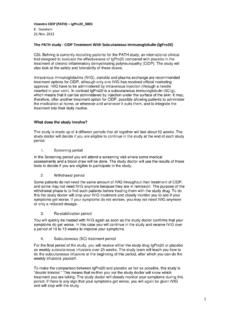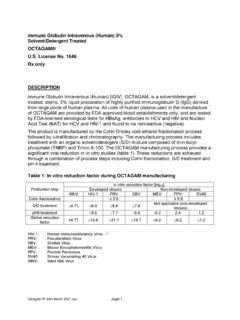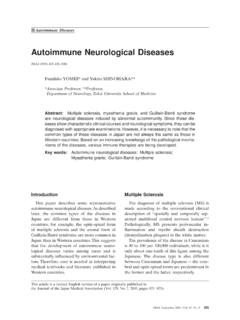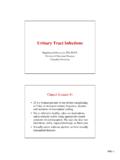Transcription of ANNEX I SUMMARY OF PRODUCT CHARACTERISTICS
1 1 ANNEX I SUMMARY OF PRODUCT CHARACTERISTICS2 This medicinal PRODUCT is subject to additional monitoring. This will allow quick identification of new safety information. Healthcare professionals are asked to report any suspected adverse reactions. See for how to report adverse OF THE MEDICINAL PRODUCTADCETRIS 50mg powder for concentrate for solution for AND QUANTITATIVE COMPOSITIONEach vial contains 50mg of brentuximab vedotin. After reconstitution (see ), each ml contains 5mg of brentuximab is an antibody-drug conjugate composed of a CD30-directed monoclonal antibody (recombinant chimeric immunoglobulin G1 [IgG1], produced by recombinant DNA technology in Chinese Hamster ovary cells) that is covalently linked to the antimicrotubule agent monomethyl auristatin E (MMAE).
2 Excipients with known effectEach vial contains approximately of sodium. For the full list of excipients, see FORMP owder for concentrate for solution for to off-white cake or powder. indicationsADCETRIS is indicated for the treatment of adult patients with relapsed or refractory CD30+ Hodgkin lymphoma (HL): 1. following autologous stem cell transplant (ASCT) or2. following at least two prior therapies when ASCT or multi-agent chemotherapy is not a treatment is indicated for the treatment of adult patients with CD30+ HL at increased risk of relapse or progression following ASCT (see ).
3 ADCETRIS is indicated for the treatment of adult patients with relapsed or refractory systemic anaplastic large cell lymphoma (sALCL).ADCETRIS is indicated for the treatment of adult patients with CD30+ cutaneous T-cell lymphoma (CTCL) after at least 1 priorsystemic therapy(see ). and method of administrationBrentuximab vedotin should be administered under the supervision of a physician experienced in the use of anti-cancer recommended dose is administered as an intravenous infusion over 30minutes every 3 recommended starting dose for the retreatment of patients with relapsed or refractory HL or sALCL who have previously responded to treatment with ADCETRIS is administered as an intravenous infusion over 30minutes every 3weeks.
4 Alternatively, treatment may be started at the last tolerated dose (see section ).Renal impairmentThe recommended starting dose in patients with severe renal impairment is administered as an intravenous infusion over 30minutes every 3weeks. Patients with renal impairment should be closely monitored for adverse events (see ).Hepatic impairmentThe recommended starting dose in patients with hepatic impairment is administered as an intravenous infusion over 30minutes every 3weeks. Patients with hepatic impairment should be closely monitored for adverse events (see section ).
5 If the patient s weight is more than 100kg, the dose calculation should use 100kg (see ).Complete blood counts should be monitored prior to administration of each dose of this treatment (see ). Patients should be monitored during and after infusion (see ). Treatment should be continued until disease progression or unacceptable toxicity(see ).Patients with relapsed or refractory HL or sALCL who achieve stable disease or better should receive a minimum of 8 cycles and up to a maximum of 16cycles (approximately 1year) (see ). For patients with HL at increased risk of relapse or progression following ASCT, ADCETRIS treatment should start following recovery from ASCT based on clinicaljudgment.
6 These patients should receive up to 16cycles (see ).Patients with CTCL shouldreceive up to 16 cycles(see ).Dose adjustmentsNeutropeniaIf neutropenia develops during treatment it should be managed by dose Table 1 below for appropriate dosing recommendations (see also ). 4 Table 1: Dosing recommendations for neutropeniaSeverity grade of neutropenia(signs and symptoms [abbreviated description of CTCAEa])Modification of dosing scheduleGrade 1 (<LLN -1500/mm3 <LLN - x 109/L) orGrade 2 (<1500 - 1000/mm3 < x 109/L)Continue with the same dose and scheduleGrade 3 (<1,000 -500/mm3 < - x 109/L) orGrade 4 (<500/mm3 < x 109/L)Withhold dose until toxicity returns to Grade2 or baseline then resume treatment at the same dose and schedule b.
7 Consider growth factor support (G-CSF or GM-CSF) in subsequent cycles for patients who develop Grade 3 or Grade4 based on National Cancer Institute (NCI)Common Terminology Criteria for Adverse Events (CTCAE) ; see Neutrophils/granulocytes; LLN= lower limit of who develop Grade3 or Grade4 lymphopenia may continue treatment without interruption. Peripheral neuropathyIf peripheral sensory or motor neuropathy emerges or worsens during treatment see Table 2 below for appropriate dosing recommendations (see section ).Table 2: Dosing recommendations for newor worsening peripheral sensory or motor neuropathySeverity of peripheral sensory or motor neuropathy (signs and symptoms [abbreviated description of CTCAEa])Modification of dose and scheduleGrade 1 (paraesthesia and/or loss of reflexes, with no lossof function)Continue with the same dose and schedule Grade 2 (interfering with function but not with activities of daily living) or Grade 3 (interfering with activities of daily living)
8 Withhold dose until toxicity returns to Grade1 or baseline, then restart treatment at a reduced dose of every 3 weeksGrade 4 (sensory neuropathy which is disabling or motor neuropathy that is life threatening or leads to paralysis)Discontinue based on National Cancer Institute (NCI)Common Terminology Criteria for Adverse Events (CTCAE) ; see neuropathy: motor; neuropathy: sensory; and neuropathic pain. ElderlyBased upon population PK analyses (see section ) andthe safety profilein elderly patients, which are consistent with that of adult patients, the dosing recommendations forpatientsaged 65 and older are the same as for population The safety and efficacy of children less than 18yearshave not yet been established.
9 Currently available data are described in , and but no recommendation on a posology can be nonclinical studies, thymus depletion has been observed (see ).5 Method of administration The recommended dose of ADCETRIS is infused over 30minutes. For instructions on reconstitution and dilution of the medicinal PRODUCT before administration, see section vedotin must not be administered as an intravenous push or bolus. Brentuximab vedotin should be administered through a dedicated intravenous line and it must not be mixed with other medicinal products (see ).
10 To the active substance or to any of the excipients listed in Combined use of bleomycin and brentuximab vedotin causes pulmonary toxicity. warnings and precautions for useProgressive multifocal leukoencephalopathyJohn Cunningham virus (JCV) reactivation resulting in progressive multifocal leukoencephalopathy(PML) and death can occur in brentuximab vedotin-treated patients. PML has been reported in patients who received this treatment after receiving multiple prior chemotherapy regimens. PML is a rare demyelinating disease of the central nervous system that results from reactivation of latent JCV and is often fatal.

















![(See DOSAGE and ADMINISTRATION [2.4.], …](/cache/preview/9/e/3/e/9/3/6/8/thumb-9e3e936878209d5fde0ef15a4eba9055.jpg)